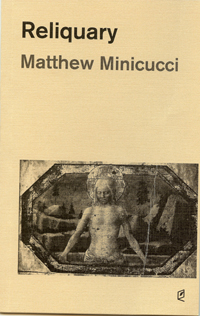Reliquary by Matthew Minicucci
 Reliquary
Reliquary
by Matthew Minicucci
Accents Publishing, 2013
21 pages / $5 Buy from Accents Publishing
With a 15th century Jacopo Bellini panel stretched across a nearly gilded cover, pages the color of bone, and vacillating moments of nostalgic faith and analytical skepticism, Matthew Minicucci’s debut chapbook Reliquary feels like it could have been produced by Andy Warhol’s idiosyncratic Catholicism. John Updike, in discussing the 1989 retrospective of Warhol’s work at The Museum of Modern Art, recounts Warhol’s infamous closet Catholicism, his private acts of grace, and his daily attendance at Mass before finding the “Catholic negativity” of “profound hollowness” in Warhol’s canon. Updike’s conclusion appears in his trademark parallelism: “Protestantism, when it fades, leaves behind a fuzzy idealism; Catholicism, a crystalline cynicism.”
Minicucci’s work exudes the skepticism of a mind that still finds faith and ritual beautiful. Such is the tattoo of literary Catholicism: the whispers of youth remain as scars for some, a bright complexion for others. Reliquary is focused on a class of elementary school students led through the fourteen Stations of the Cross by their teacher, Sister Theresa. Two students in particular–the narrator and his friend Chris–return within narratives replete with philosophical and theological asides. Minicucci leads the first poem with an epigraph from Horace, referencing the Promethean act of “making each of us,” the correct precedent for a collection of poems so focused on hands, on faith formation. From the first poem alone, “Jesus is Condemned to Death”: “the perfect curve of marble hands connecting / supple to supplication”; “how Jesus’ index and middle finger separate / from the thumb, point to the sky as Pilate reads”; “Caiaphas stands with his hands outstretched / fingers splayed and downward”; “Sister Theresa sets her hand on my thigh, / presses nails into flesh, pushing / my small knee to the floor.” The focus on hands and palms is to be expected in a Catholic ritualistic milieu: the receipt of the Host, the offering of peace, yet Minicucci focuses on the terrible strength of touch. He must kneel at the first Station in order “to meditate / on each prick of thorn and pull of the lash.” Sister Theresa tells him that “This is what suffering looks like . . . It’s beautiful.”
March 8th, 2013 / 12:00 pm
